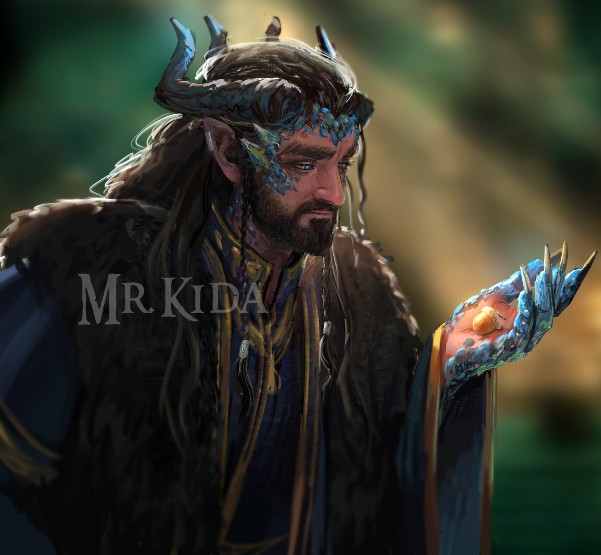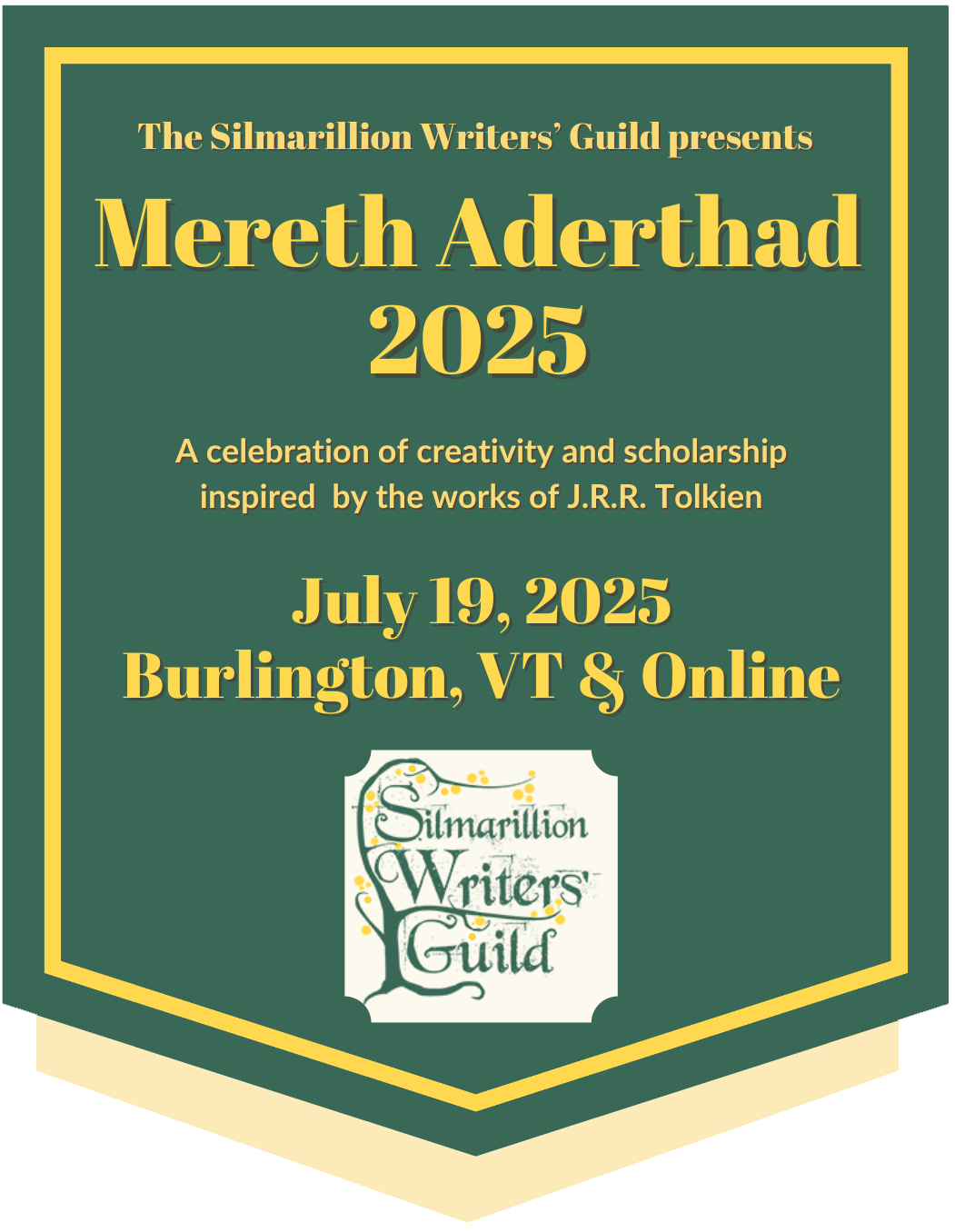Interview with cloudyhymns by Shadow by cloudyhymns, daughterofshadows
Posted on 2 April 2025; updated on 2 April 2025
This article is part of the newsletter column Mereth Aderthad.

At Mereth Aderthad 2025, cloudyhymns will be presenting on "The Design of Dragons and the Doom of the Dwarves," making the case that dragons—the origins and nature of which we know very little—could be seen as a corruption of Dwarves. Shadow had a chance to speak with cloudyhymns about his work and his theories on dragons and Dwarves.
Shadow: We're sitting down today to discuss your upcoming Mereth Aderthad presentation "The Design of Dragons and the Doom of the Dwarves" and give attendees the chance to meet you and your topic, so they know what they can get excited for. But before we discuss your current project, are there any previous works—scholarly, fannish, or both—that you want us to highlight?
Cloudyhymns: I’ve always been a bit of a fandom wanderer and am newer to writing for The Silmarillion. The most relevant project I have permission to share is my research in the 30-Day Character Study I did on Celebrimbor, which I took on as a more casual “playing in the sandbox” work. When it comes to scholarly works, my past writings on Tolkien are property of my undergraduate university, and that university does not permit me to share them. My favorite, however, was a reading of water as The Road in The Lord of the Rings. If you’re interested in other fannish research, I’d point you towards my investigation of Teyvat’s Abyssal Galaxy Band for the Khaenri’ah Lore Project. I don’t think that KLP has a website at the moment, so the link is to the original document from July of 2021.
Shadow: Fascinating! Thank you so much for sharing these, I hope our readers will enjoy looking into them!
It’s been a lot of fun to learn about each presenter’s journey into Tolkien’s works. What first drew you to his stories? Or alternatively, what is your favourite part of the legendarium and why?
Cloudyhymns: The musicality of his work is my answer to both! The best advice I’ve been given is “Read it out loud.” To me, it is when Tolkien’s works, both poetry and prose, are spoken that the cleverness and craft become clear. My favorite part of the Legendarium is from an early version of Túrin’s rescue in the The Lay of the Children of Húrin. It is Beleg’s whetting spell and the description that follows:
Then whistling whirled he the whetted sword-blade
and three times three it threshed the gloom,
till flame was kindled flickering strangely
like licking firelight in the lamp's glimmer
blue and baleful at the blade's edges.1
Now that you’ve read it, try reading it out loud! Has anything changed? The “whistling whirled he” verses, as I call them, are magical. The structure, the alliteration, and swing of the lay mirrors the looping motions as Beleg gets Anglachel to whistle—or sing—in his stead. To me, the whetting spell is an example of Tolkien playing with the nature of Song and the spoken word. Likewise, Beleg “murmur[s]” to invoke Song in Anglachel.2 It is my reading that in Tolkien’s Legendarium, Song and speech are the same, if the spoken word is given enough intention. I would love to see more, so if you’re reading this and have relevant examples of Song and spoken versus sung word, please let me know about it! There’s far more that can be explored in the whetting spell and “whistling whirled he” verses, such as the interweaving of creation, Song, and sacrifice; the appearance of the number nine in a scene centered around mortality and doom; and the history of Anglachel, the heavens, and Eöl, but I’ll leave the discussion here for now.
Shadow: Oh, it's been forever since I read The Children of Húrin, thank you for reminding me of this gorgeously written scene! And you have some fascinating insights on Songs and spells in Tolkien. You probably could have done an entirely different presentation on that topic as well! But for now, let's focus on the presentation you will be giving at Mereth Aderthad. As the title suggests, you will be talking to us about dragons and Dwarves. What made you choose this topic?
Cloudyhymns: Indeed! The interweaving of dragons and Dwarves was one of five or six different topics I played with—in the end, it was the one I knew I could prepare in time for this year’s Mereth Aderthad. The original germ of an idea stemmed from the Völsunga Saga: if the Dwarf Fafnir could turn into a dragon to guard his stolen treasure, could a similar corruption occur in Morgoth’s halls? I intended it for essay format in 2020, I believe, but it lingered shapelessly until recently. I returned to the connection between Dwarves and dragons around the holidays, when I stumbled upon several references to the material of Arda being irreducible beyond its constituents—iron remaining iron and so forth. Not too distant from atomic theory. How, therefore, could a dragon of old destroy one of the Rings of Power, as Gandalf says? Perhaps because it is in their nature to not only guard, but to consume, untying the Magic binding the Rings to the fabric of Arda as they did with several of the Seven.
Shadow: That is absolutely fascinating! So you are suggesting that Morgoth made dragons from corrupted dwarves, in a similar vein that he made Orcs from corrupted Elves, and in that process, the Dwarves' desire to craft turned into a desire to unmake instead?
Cloudyhymns: That is certainly my reading of it, although which race or species was corrupted into dragons isn’t specified. The dragons are almost certainly corruptions—Glaurung is “the first of the Urulóki”, and the Noldor call him a “new thing”3; likewise, dragons are not mentioned in Aman, even though every manner of beasts and creatures are found there. Huan and Nahar, for example, are considered creatures despite their excellence—ragons must have come from a different line that is unrelated to wildlife. Could there be a different race involved? Yes, although I personally find it hard to believe that Hobbits, Ents, and the like could be made into dragons. The same goes for dragons as descendants of the Maiar—it is possible, though I will say we never hear about baby Balrogs terrorizing the inhabitants of Middle-earth. Now that’s something I would read! Why, then, do the Valar turn a blind eye to the dragons? I would argue that it is what you said: making turning to unmaking. Aulë and Yavanna discuss this in their chapter of The Silmarillion, “Of Aulë and Yavanna.” The newly crafted Dwarves have the potential to trigger widespread ecological destruction and resource depletion; checks and balances are required. Luckily for Yavanna, dragons fill the gap and return the materials used by the Dwarves to Middle-earth.
Shadow: Oh, the implications of that are so intriguing! Especially since I very much enjoy playing around with that aspect of the Dwarves' creation and having them take active steps to balance their impact on the world in fanfiction myself. You're mentioning that the dragons return the materials used by the Dwarves to Middle-earth. In your eyes, what role do their hoards play in that cycle? At first glance, it appears to me that hoards would just change the "ownership", if one can call it that, of the materials, rather than returning them.
Cloudyhymns: There’s an aspect of that, for sure! What stands out to me is that a portion of the hoards are destroyed by dragon-fire, or else important pieces are eaten. This is mentioned in The Fellowship of the Ring, I believe, by Gandalf—as far as the Wise know, four of the seven rings of the Dwarves have been removed in this manner. Given those rings are never found by Sauron, I’d argue they did not survive beyond the death of the dragons who consumed them, whether they were hit by dragon-fire and undone like a melting furnace or destroyed through some slower, internal process. I see it within the realm of possibility that dragons are called by the rings, but perhaps the ringbearers were simply unlucky!
Shadow: Well, this conversation has certainly gotten me very excited for your presentation in July! If the audience takes one thing away from your talk on that day, what do you hope it will be?
Cloudyhymns: First and foremost, please make of it what you will! I’ve never been a fan of there being one meaning or interpretation of a work that is better than others—my favorite literary work is Calvino’s If on a winter's night a traveler (if you know, you know). Since this is Mereth Aderthad, I hope you find something to squirrel away and use in your own works, whether bits from the conflict of Aulë and Yavanna, the divergence of Aulë and Melkor, the options for corruptible species, or the Ring Cycle itself, as the Völsunga Saga led also to Wagner’s operas. If you’re going for a more direct Dwarf-to-dragon lineage, I know Thorin turning into a dragon tends to be popular with Bagginshield, but how would that change the rearguard of Belegost’s stand against Glaurung? Or the Dragon-helm of Dor-lómin? While I don’t aim to direct you towards one ramification of the Dwarf-dragon connection over another, I’m happy to share my favorite: that Telchar’s design of the Dragon-helm may be read as an act of resistance and reclamation of bodily autonomy.
Notes
- The Lays of Beleriand, The Lay of the Children of Húrin, “Beleg,” 1219-1223.
- Ibid., 1205.
- The Silmarillion, "Of the Return of the Noldor."

